Alfa Romeo Giulia
| Alfa Romeo Giulia (Type 105) | |
|---|---|
 Alfa Romeo Giulia Super | |
| Overview | |
| Manufacturer | Alfa Romeo |
| Production | 1962–1978 |
| Assembly |
Portello, Milan, Italy (1962–1965) Arese, Milan, Italy (1965–1978) Setúbal, Portugal (Movauto) |
| Designer | Giuseppe Scarnati |
| Body and chassis | |
| Class | Large family car (D) |
| Body style |
4-door saloon 4-door station wagon |
| Layout | Front-engine, rear-wheel-drive |
| Related | |
| Powertrain | |
| Engine | |
| Transmission |
4-speed manual (Giulia 1300) 5-speed manual |
| Dimensions | |
| Wheelbase | 2,510 mm (98.8 in)[1] |
| Length | 4,140 mm (163.0 in)[2] |
| Width | 1,560 mm (61.4 in)[2] |
| Height | 1,430 mm (56.3 in)[2] |
| Kerb weight | 978–1,130 kg (2,156–2,491 lb)[3] |
| Chronology | |
| Predecessor | Alfa Romeo Giulietta (750/101) |
| Successor | Alfa Romeo Giulietta (116) |
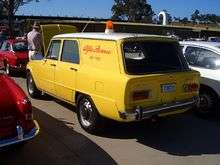
The Alfa Romeo Giulia is both a line of sporty four-door passenger car (Type 105) produced by Italian car manufacturer Alfa Romeo from 1962 to 1978 and updated, mainly up-engined Spider, Sprint and Sprint Speciale Giuliettas.
Alfa Romeo was one of the first mainstream manufacturers to put a powerful engine in a light-weight 1,000 kilograms (2,205 lb) four-door car for mass production. The Type 105 Giulia was equipped with a light alloy twin overhead camshaft four-cylinder engine similar to that of the earlier Giulietta (750/101) range, available in 1.3-litre (1,290 cc) and 1.6-litre (1,570 cc) versions. Various configurations of carburetors and tuning produced power outputs from about 80 to about 110 bhp (55 to 75 kW), coupled in most cases to 5-speed manual transmission.
Giulia sedans were noted for lively handling and impressive acceleration among small European four-door sedans of their era, especially considering modest engine sizes offered. The popular Super version with the twin carburettor 1.6 litre engine had a top speed of 170 km/h (106 mph) and accelerated from 0 to 100 km/h (62 mph) in about 12 seconds, better than many sports cars of the late 1960s and early 1970s. When leaving the factory all variations of the Giulia originally fitted either Pirelli Cinturato 165HR14 tyres (CA67) or Pirelli Cinturato 155HR15 tyres (CA67).
The styling of the boxy four-door sedan was somewhat wanting. The engine bay, cabin and boot were all square shaped, buffered somwhat by details on the grill, roofline, bonnet and boot. Use of a wind tunnel during development led to a very aerodynamic shape that produced a drag coefficient of Cd=0.34,[4][5] particularly low for a saloon of the era.
The Giulia Spider was succeeded by the Alfa Romeo Spider (105/115) in 1966.
Models
Giulia TI
The Type 105 Giulia was introduced with the Tipo 105.14 in 1962. It was fitted with a 1,570 cc Alfa Romeo Twin Cam inline 4, which produced 92 PS (68 kW; 91 hp) at 6500 rpm with single down-draft carburettor. The "TI" nomenclature referred to a class of Italian saloon car racing known as "Turismo Internazionale", and had previously been applied to higher-performance versions of the 1900 and Giulietta saloons in the 1950s. However, with the subsequent introduction of the TI Super and Super, the TI became the base version for the 1,600 cc engine class. Standard steering column gearchange was replaced with floor change for 1964 (Tipo 105.08). Right hand drive was available from 1964 with floor change only (Tipo 105.09). Brakes were by drums all around at first, followed by front then four-wheel disk brakes. A brake servo was introduced in later cars. The steering wheel featured the only horn ring ever in the Giulia range. The dashboard was notable for its a strip speedometer. The Giulia TI was phased out in 1968 and re-introduced as the austerity 1600 S model (see below).
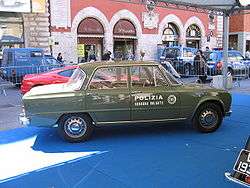
Giulia TI Super
Tipo 105.16 was a special racing model introduced in 1963. Quadrifoglio Verde (green four-leaf clover) stickers on the front wings were a distinguishing feature. Only 501 were made for homologation and today it is very rare and desirable.[6] The 1,570 cc engine was fitted with two double-choke horizontal Weber 45DCOE carburettors for 112 PS (82 kW; 110 hp) at 6500 rpm. The body was lightened and a floor gearchange was fitted as standard, as were alloy wheels of very similar appearance to the standard steel ones of the TI. The TI's instrument cluster with its strip speedometer was replaced with a three-instrument binnacle comprising speedometer, tachometer and a multi-gauge instrument (fuel, water temperature, oil temperature and pressure) - these instruments were similar to those fitted to the contemporary Giulia Sprint and Sprint Speciale coupes and Spider convertibles. The steering wheel was a three-spoke item with centre hornpush, also similar to that of the more sporting models. Braking was by discs all around, although the first cars used drums (triple leading shoe on the front) and early disc models lacked a servo which was introduced later. The police cars seen in The Italian Job were of this type.
Giulia 1300
Tipo 105.06 was an austerity model made from 1964 to 1970 with a 1,290 cc single-carburettor engine for 78 PS (57 kW; 77 hp) at 6000 rpm. Four-speed gearbox with floor change fitted as standard (the 1300 was the only Giulia model not fitted with a five-speed gearbox). Though the engine was given a 105 series type number, it was basically the engine from the 101 series Giulietta Ti. This model appears not to have been exported to many markets outside Italy, if at all. Braking was by discs all around, without a servo at first, later with a servo.
Giulia Super
Tipo 105.26 was introduced in 1965. It transferred the technology from the racing TI Super to a road car, to make the most successful Giulia saloon. 1,570 cc engine with two double-choke Weber 40DCOE carburettors for a milder, but torquier tune than the TI Super - 98 PS (72 kW; 97 hp) at 5500 rpm. New dashboard with two large round instruments (speedo and tacho) and clock. Sportier steering wheel with three aluminium spokes and centre horn push, similar to that of the Ti Super, later changed for one with the horn pushes in the spokes. All-around disc brakes with servo were fitted as standard from the outset. The serpent crest of the Sforza family appears in a badge on the C-pillar and is a distinguishing feature of the Super. For 1968, there was a suspension update, including revised geometry and a rear anti-roll bar. The wheels were changed in size from 5J x 15 to 5J x 14, and tires from 155/15 to 165/14. For 1970, updates included dual-circuit brakes, centre-mounted handbrake lever to replace under-dash "umbrella handle", larger external doorhandles, and top-hinged pedals (the latter in left hand drive models only; right hand drive continued with bottom-hinged pedals to the end of production). In 1972, Tipo 105.26 was rationalised into the Giulia 1.3 - Giulia 1.6 range (see below).
| Version | Years of production |
|---|---|
| Giulia 1600 TI | from 1962 to 1967 |
| Giulia 1600 TI Super | from 1963 to 1964 |
| Giulia 1300 | from 1964 to 1971 |
| Giulia Super | from 1965 to 1972 |
| Giulia 1300 ti | from 1966 to 1972 |
| Giulia 1300 Super | from 1970 to 1972 |
| Giulia 1600 S | from 1968 to 1970 |
| Giulia Super 1.3 | from 1972 to 1974 |
| Giulia Super 1.6 | from 1972 to 1974 |
| Giulia Nuova Super 1.3 | from 1974 to 1977 |
| Giulia Nuova Super 1.6 | from 1974 to 1977 |
| Giulia Nuova Super Diesel | from 1976 to 1977 |
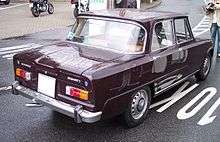
Giulia 1300 ti
Tipo 105.39 was built from 1965 to 1972. Right hand drive model replaced in 1970 by the 1300 Super (see below). It mounted a 1,290 cc engine with single down-draft carburettor for 82 PS (60 kW; 81 hp) at 6000 rpm. Unlike the re-deployed 101-series Giulietta engine of the austerity-model 1300, the 1300 ti motor was a 105 series engine, basically that of the sportier GT1300 Junior coupe with different camshaft timing (but the same camshafts) and induction system. Other features were the five-speed gearbox, a three-spoke bakelite steering wheel with plastic horn push covering the centre and spokes, and the dashboard initially with strip speedo like that of the TI. For 1968, updates included a dashboard based on that of the Super, but with a simpler instrument binnacle, still featuring two large round instruments (speedo and tacho) and a separate fuel gauge, and the same suspension, wheel and tire updates applied to the Giulia Super in the same year. 1970 updates included dual-circuit brakes, centre handbrake, larger external doorhandles and top-hinged pedals (on left hand drive cars only), again as applied to the Super for that year.
Giulia 1600 S
Tipo 105.85 was basically a Giulia TI re-introduced in 1968 as a lower-level model to come between the 1300 and 1300 ti on one hand, and the Super on the other. It had a re-interpretation of the 1,570 cc single-carburettor engine for 95 PS (70 kW; 94 hp) at 5500 rpm and similar trim to the 1300 ti. Replaced in 1970 by the 1300 Super (see below) which offered similar performance in a lower tax bracket. The last cars from 1970 featured the top-hinged pedals, centre handbrake and dual-circuit brakes as for the Super and 1300 ti.
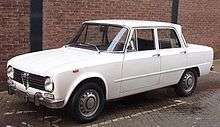
Giulia 1300 Super
Tipo 115.09 was introduced in 1970. It was basically a 1300 ti fitted with the engine from the GT 1300 Junior coupe that featured two double-choke horizontal carburettors; the engine actually had the GT 1300 Junior type number. This model was rationalised into the Giulia Super 1.3 - Giulia Super 1.6 range in 1972.
Giulia Super 1.3 and Giulia Super 1.6
In 1972 a rationalisation of the Giulia range saw the Super 1300 (Tipo 115.09) and the Super (Tipo 105.26) re-released as the Super 1.3 and Super 1.6. The two models featured the same equipment, interior and exterior trim, differing only in engine size (1,290 cc and 1,570 cc) and final drive ratio. The 1300 ti was dropped. A small Alfa Romeo badge on the C-pillar is a distinguishing feature, as are hubcaps with exposed wheel nuts.
1600 Rallye
In December 1972 Alfa-Romeo South Africa released the 1600 Rallye. This locally developed more powerful 1600 cc version of the 1300 Super, using the 1300's single-headlight body shell. The car was largely ready for competition and was only planned to be built in limited numbers, and was fitted with racing-style rear-view mirrors, rally lamps, fully adjustable seats, and a limited-slip differential.[7] Claimed power was 125 hp (93 kW; 127 PS) SAE.[7]
Giulia Nuova Super
The Giulia Super range was re-released in 1974 as the Nuova Super range, including the Giulia Nuova Super 1300 and 1600 This and featured a new black plastic front grille and a flat boot (trunk) lid without the characteristic centre spine. Otherwise the cars differed little from their Giulia Super predecessors and bore the same Tipo numbers with an S suffix. Production ceased in 1977.
Giulia Nuova Super Diesel
A Nuova Super fitted with a Perkins 1,760 cc diesel for 55 PS (40 kW; 54 hp) at 4000 rpm. The firm's first attempt at diesel power. The same Perkins diesel was used also in Alfa Romeo F12 van. The diesel version was slow, 138 km/h (86 mph), and the engine somehow unsuitable for a sport sedan so it was not big seller, only around 6500 examples made in 1976.
Engines and performance
Unless noted otherwise, DIN rated horsepower and torque is given.
| Model | Years | Engine | Compr. ratio | Fuel system | Power | Torque | Top speed |
|---|---|---|---|---|---|---|---|
| Giulia 1300 | 1964–71 | 1,290 cc Twin Cam | 8.5:1 | 1x twin carb. | 78 PS (57 kW; 77 hp) at 6,000 rpm | 102 N·m (75 lb·ft) at 4,700 rpm[9] | 155 km/h (96 mph) |
| Giulia 1300 ti | 1966–72 | 9.0:1 | 1x twin carb. | 82 PS (60 kW; 81 hp) at 6,000 rpm | 104 N·m (77 lb·ft) at 4,900 rpm[10] | 160 km/h (99 mph) | |
| Giulia 1300 Super | 1970–72 | 9.0:1 | 2x twin carbs. | 89 PS (65 kW; 88 hp) at 6,000 rpm | 140 N·m* (103 lb·ft) at 3,200 rpm[11] | 165 km/h (103 mph) | |
| Giulia Super 1.3 | 1972–74 | ||||||
| Giulia Nuova Super 1300 | 1974–77 | ||||||
| Giulia TI | 1962–67 | 1,570 cc Twin Cam | 9.0:1 | 1x twin carb. | 92 PS (68 kW; 91 hp) at 6,200 rpm | 130 N·m (96 lb·ft) at 4,000 rpm[12] | 165 km/h (103 mph) |
| Giulia TI Super | 1963–64 | 9.7:1 | 2x twin carbs. | 112 PS (82 kW; 110 hp) at 6,500 rpm | n/a | 185 km/h (115 mph) | |
| Giulia 1600 S | 1969–70 | 9.0:1 | 1x twin carb. | 95 PS (70 kW; 94 hp) at 5,500 rpm | n/a | 170 km/h (106 mph) | |
| Giulia Super | 1965–69 | 9.0:1 | 2x twin carbs. | 98 PS (72 kW; 97 hp) at 5,500 rpm | 136 N·m (100 lb·ft) at 3,000 rpm[13] | 175 km/h (109 mph) | |
| 1969–72 | 9.0:1 | 2x twin carbs. | 102 PS (75 kW; 101 hp) at 5,500 rpm | 162 N·m* (119 lb·ft) at 2,900 rpm[14] | 175 km/h (109 mph) | ||
| Giulia Super 1.6 | 1972–74 | ||||||
| Giulia Nuova Super 1600 | 1974–77 | ||||||
| Giulia Nuova Super Diesel | 1976–77 | 1,760 cc Perkins 4.108 diesel | 22:1 | Injection pump | 55 PS* (40 kW; 54 hp) at 4,000 rpm | 101 N·m* (74 lb·ft) at 2,200 rpm | 138 km/h (86 mph) |
- Notes
- * SAE rated
Giulia Spider, Sprint and Sprint Speciale
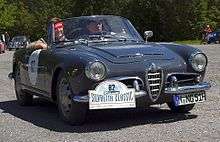

The Spider, Sprint and Sprint Speciale Giulias introduced together with the Giulia sedan in 1962 were rebadged and updated versions of earlier Giulietta models (series 101), now with a 1.6 litre instead of a 1.3 litre engine. Easiest to distinguish from a Giulietta is the Spider, which featured a bonnet bulge to clear the slightly taller engine. The Sprint coupe was also available for a short time with the 1.3 litre engine as the Sprint 1300 - essentially a Giulietta Sprint with a different name. Most models were discontinued in 1964. The Sprint Speciale continued until 1966.
2015 Alfa Romeo Giulia (952)
The Giulia (952) compact executive car was unveiled on 24 June 2015 at the Museo Storico Alfa Romeo in Arese. The all-new model is the first product of the company's revival plan, which will see the brand return to a rear wheel drive platform[15] with the option of all wheel drive. The new model was shown in the high-performance "Quadrifoglio" specification.
See also
- Alfa Romeo Sprint GT (Veloce)
- Alfa Romeo Spider
- Alfa Romeo Giulia TZ
- Alfa Romeo Giulia Sprint Speciale
- Alfa Romeo GTA
- Alfa Romeo Montreal
Notes
- ↑ "1964 Alfa Romeo Giulia Super". hi.com. Archived from the original on 24 July 2008. Retrieved 2008-09-05.
- 1 2 3 "1964 Alfa Romeo Giulia 1300". carfolio.com. Archived from the original on 27 September 2007. Retrieved 2007-09-05.
- ↑ "Alfa Romeo Giulia". carsfromitaly.net. Archived from the original on 27 September 2007. Retrieved 2007-09-05.
- ↑ "L'Alfa Romeo Giulia festeggia 50 anni". Il Sole 24 ore. 27 June 2012. Retrieved 9 July 2012.
- ↑ "La nuova Alfa Romeo "Giulia", ultima di una serie". Panorama. 25 June 2012. Retrieved 10 July 2012.
- ↑ "1965 Alfa Romeo Giulia TI". sportscarmarket.com. Archived from the original on 9 September 2007. Retrieved 2007-09-04.
- 1 2 Wright, Cedric, ed. (December 1972). "Alfa-Romeo 1600 Rallye and 1600 GT Coupe". CAR (South Africa). Vol. 16 no. 11. Cape Town, South Africa: Ramsay, Son & Parker (Pty) Ltd. p. 17.
- ↑ Fusi (1978).
- ↑ "Alfa Romeo "Giulia 1300"". Quattroruote (road test). Editoriale Domus (104). August 1964.
- ↑ "Alfa Romeo "Giulia 1300 ti"". Quattroruote (road test). Editoriale Domus (123): 100–109. March 1966.
- ↑ "Alfa Romeo "Giulia 1300 Super"". Quattroruote (road test). Editoriale Domus (181): 84–93. January 1971.
- ↑ "Alfa Romeo "Giulia T.I."". Quattroruote (road test). Editoriale Domus (80): 72–83. August 1962.
- ↑ "Alfa Romeo Giulia Super". Motor (road test). 9 July 1966.
- ↑ "Alfa Romeo "Giulia Super 1.6"". Quattroruote (road test). Editoriale Domus (198): 108–119. June 1972.
- ↑ "The Alfa Romeo Giulia is a 503bhp, RWD super-saloon". Top Gear. 2015-06-24. Retrieved 2016-07-04.
References
- Fusi, Luigi (1978). Alfa Romeo—Tutte le vetture dal 1910—All cars from 1910 (3rd ed.). Milan: Emmeti Grafica editrice.
External links
| Wikimedia Commons has media related to Alfa Romeo Giulia. |
- Motorbase: Alfa Romeo Giulia Ti/Super (1962–1972)
- Motorbase: Alfa Romeo Giulia Sprint GT/Sprint GT Veloce/GTC (1963–1968)
- Motorbase: Alfa Romeo Giulia 1300/1300TI/1300 Super (1964–1972)
- All models and series, provided with images and descriptions
- Alfa Romeo Giulia at the Internet Movie Cars Database
| « previous — Alfa Romeo car timeline, 1950s–1970s — next » | ||||||||||||||||||||||||||||||||
|---|---|---|---|---|---|---|---|---|---|---|---|---|---|---|---|---|---|---|---|---|---|---|---|---|---|---|---|---|---|---|---|---|
| Type | 1950s | 1960s | 1970s | |||||||||||||||||||||||||||||
| 0 | 1 | 2 | 3 | 4 | 5 | 6 | 7 | 8 | 9 | 0 | 1 | 2 | 3 | 4 | 5 | 6 | 7 | 8 | 9 | 0 | 1 | 2 | 3 | 4 | 5 | 6 | 7 | 8 | 9 | |||
| Small family car | Dauphine | Alfasud | ||||||||||||||||||||||||||||||
| Compact executive car | Giulietta (750/101) | |||||||||||||||||||||||||||||||
| Giulia | Giulietta (116) | |||||||||||||||||||||||||||||||
| Executive car | 1750 Berlina | Alfetta | ||||||||||||||||||||||||||||||
| 2000 Berlina | Alfetta 2000 | |||||||||||||||||||||||||||||||
| 1900 | 2000 | 2600 | Alfa 6 | |||||||||||||||||||||||||||||
| Coupé | Giulietta Sprint | GT Junior | Alfasud Sprint | |||||||||||||||||||||||||||||
| Giulia Sprint GT/GT Veloce | Alfetta GT and GTV | |||||||||||||||||||||||||||||||
| 1900 Sprint | 2000 Sprint | 2600 Sprint | ||||||||||||||||||||||||||||||
| Cabriolet | 1900 L | Giulia GTC | ||||||||||||||||||||||||||||||
| Spider | Giulietta Spider | Spider | ||||||||||||||||||||||||||||||
| 2000 Spider | 2600 Spider | |||||||||||||||||||||||||||||||
| Roadster | Gran Sport Quattroruote | |||||||||||||||||||||||||||||||
| Sports car | 6C 2500 | Montreal | ||||||||||||||||||||||||||||||
| 33 Stradale | ||||||||||||||||||||||||||||||||
| Racing car | TZ | GTA | ||||||||||||||||||||||||||||||
| 158/159 | Tipo 33 | 177/ 179 | ||||||||||||||||||||||||||||||
| Off-road | Matta | |||||||||||||||||||||||||||||||
| LCV | Romeo | Romeo 2 | Romeo 3 | F11/F12/A11/A12 | ||||||||||||||||||||||||||||
| AR8 | ||||||||||||||||||||||||||||||||
